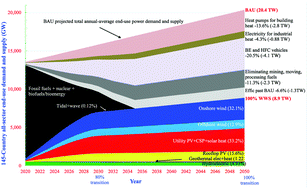Low-cost solutions to global warming, air pollution, and energy insecurity for 145 countries†
Abstract
Global warming, air pollution, and energy insecurity are three of the greatest problems facing humanity. Roadmaps are developed and grid analyses are performed here for 145 countries to address these problems. The roadmaps call for a 100% transition of all-purpose business-as-usual (BAU) energy to wind-water-solar (WWS) energy, efficiency, and storage, ideally by 2035, but by no later than 2050, with at least 80% by 2030. Grid stability analyses find that the countries, grouped into 24 regions, can exactly match demand with 100% WWS supply and storage, from 2050–2052. Worldwide, WWS reduces end-use energy by 56.4%, private annual energy costs by 62.7% (from $17.8 to $6.6 trillion per year), and social (private plus health plus climate) annual energy costs by 92.0% (from $83.2 to $6.6 trillion per year) at a present-value cost of ∼$61.5 trillion. The mean payback times of the capital cost due to energy- and social-cost savings are 5.5 and 0.8 years, respectively. WWS is estimated to create 28.4 million more long-term, full-time jobs than lost worldwide and may need only ∼0.17% and ∼0.36% of world land for new footprint and spacing, respectively. Thus, WWS requires less energy, costs less, and creates more jobs than BAU. Sensitivity test indicate the following. Increasing district heating and cooling may reduce costs by allowing flexible loads to replace inflexible loads, thereby replacing electricity storage and overgeneration with low-cost heat storage. A battery cost that is 50% higher than in the base case increases mean overall energy costs by only 3.2 (0.03–14.5)%. Almost all regions need fewer hours of load shifting than assumed in the base case, suggesting that actual load shifting may be easier than assumed. Increasing the use of electricity for hydrogen fuel-cell-electric vehicles instead of for battery-electric vehicles increases overall cost in most regions tested, due to the greater efficiency of battery-electric vehicles, but decreases overall cost in some regions by improving grid stability. Finally, shifting battery vehicle charging from day-night to mostly day charging reduces cost in the regions tested; shifting to mostly night charging increases cost. Ninety-five percent of the technologies needed to implement the plans proposed are already commercial.



 Please wait while we load your content...
Please wait while we load your content...